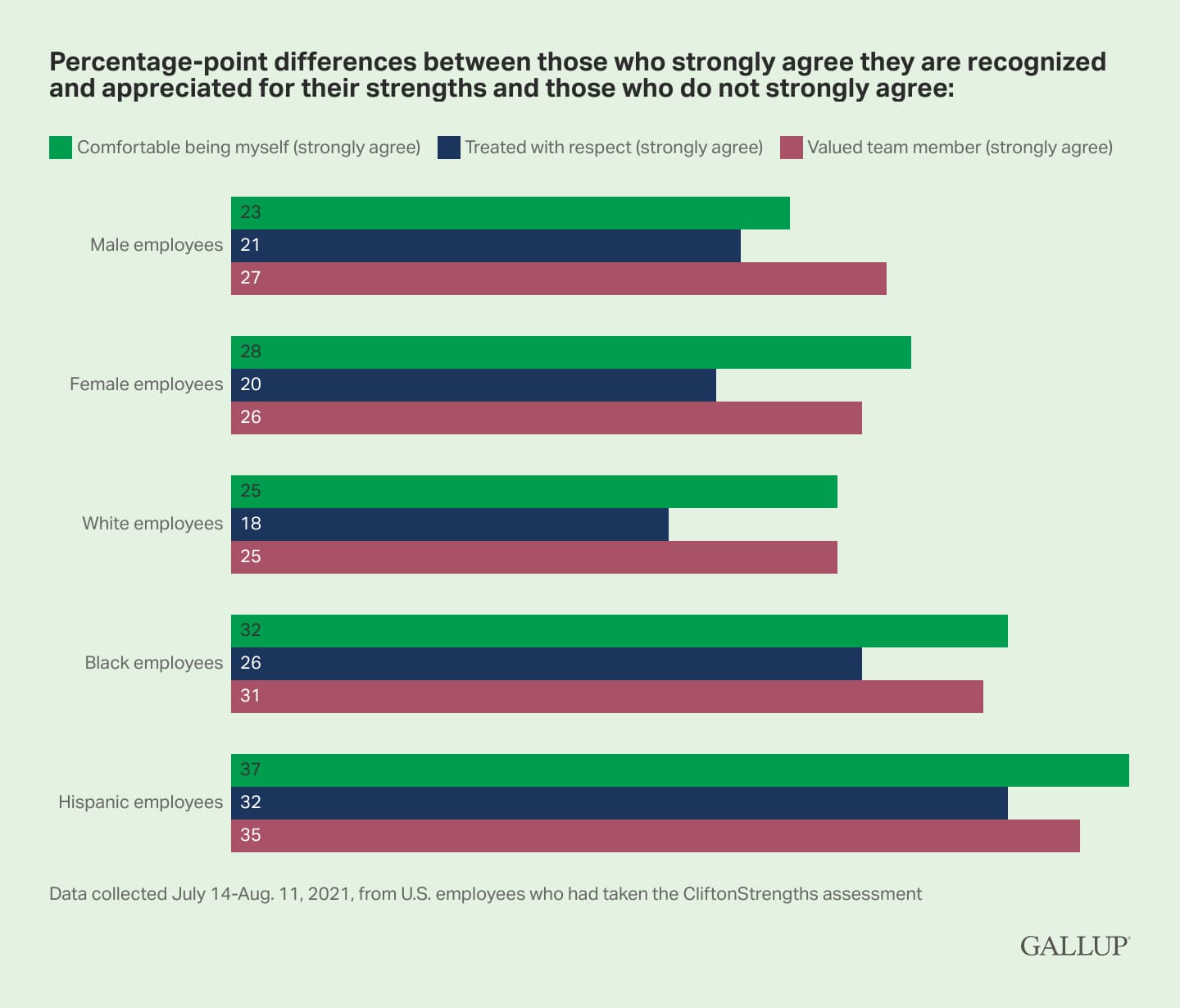Story Highlights
- Inclusive workplaces need a common, unifying language
- Employees recognized for their strengths are more committed to their organization
- Inclusive cultures thrive when employees know each other's strengths
Wanting an inclusive workplace is one thing. Knowing where to start is a whole other story.
Most leaders realize that fostering an inclusive culture is essential to unleashing the full power of their talent. Inclusive organizations help employees bring their best by providing an environment where employees feel safe being themselves and sharing their ideas.
However, many leaders struggle because the target outcomes of inclusion often appear to be more ambiguous and subjective than the tangible growth targets that many leaders feel more comfortable striving for.
At its core, inclusion is very simple: It starts with valuing your employees for who they are and what they contribute. This is something strengths-based organizations already do, which means they have a monumental head start.
Strengths as a Unifying Force
CliftonStrengths lays a strong foundation for inclusion because it provides a common language for talking about and celebrating what makes people unique -- including their backgrounds, how they approach challenges, what energizes them and more.
Inclusion starts with valuing your employees for who they are and what they contribute.
In a 2021 Gallup survey of U.S. employees who had taken the CliftonStrengths assessment, 82% agreed that being recognized for their strengths makes them feel like their coworkers appreciate them as a person.
In turn, a strengths-based workplace promotes employees' perceptions of inclusion. Employees who strongly agreed their coworkers recognize and appreciate them for their strengths were far more likely to report high levels of inclusion along key dimensions of inclusive cultures, including belonging, fairness and psychological safety -- an overall comfort with bringing what they have to offer to the table.
In fact, employees who strongly agreed that their coworkers recognize and appreciate them for their strengths were:
- 4x as likely to strongly agree that their organization is fair to everyone
- 3x as likely to strongly agree they are treated with respect at work
- 3x as likely to strongly agree they feel like a valued member of the team
- 3x as likely to strongly agree their organization values diverse ideas and opinions
- 3x as likely to strongly agree they are comfortable being themselves at work
Further, when employees are consistently seen and valued for their strengths, it helps everyone nurture their strengths for the future and encourage others to do the same. Employees who strongly agreed that they are recognized and appreciated for their strengths were four times as likely to strongly agree that their organization is committed to building the strengths of employees.
This ongoing development is how strengths-based organizations ensure that they are getting the full potential of their employees and that employees feel invested in.
A Return on Investment
Valuing employees for their strengths also builds employees' investment in their organization, which has direct benefits to the organization through improved retention and a more compelling employer brand.
Put simply, employees who are recognized for their strengths are more committed to their organization. They're more likely to report that they are not looking for another job, and they are far more likely to say they would recommend their organization as a great place to work.
Plus, focusing on strengths boosts employee wellbeing: Employees who strongly agreed that they are recognized and appreciated for their strengths were four times as likely to strongly agree that their organization cares about their overall wellbeing.
On the other hand, employees who did not strongly agree that they are recognized and appreciated for their strengths were twice as likely to report being burned out at work very often or always. A strengths-based inclusion strategy can help employees and their employers avoid the perils of burnout.
Ultimately, increased employee commitment and wellbeing, not to mention reduced turnover and burnout, make strengths-based organizations more productive (+19%), more profitable (+29%) and safer (+59%).
Strengths Can Magnify Your DEI Investments
Strengths can also be a great magnifier of other investments your organization is making in diversity, equity and inclusion (DEI). In fact, employees who strongly agreed that they are recognized and appreciated for their strengths were twice as likely to strongly agree that their organization cares about DEI.
The benefits of a strengths-based culture are equally powerful for women and men, and may be even more impactful for employees of racial and ethnic minority groups. For example, Black employees who strongly agreed they are recognized and appreciated for their strengths were 32 percentage points more likely than those who did not to say they are comfortable being themselves at work. And Hispanic employees who strongly agreed they are recognized and appreciated for their strengths were 35 points more likely than those who did not to say they feel like a valued team member.

Custom bar chart. Percentage point differences between those who strongly agree they are recognized and appreciated for their strengths and those who do not strongly agree. Male employees who do strongly agree with this statement are 23 points more likely to say they are comfortable being themselves, 21 points more likely to say they are treated with respect, and 27 points more likely to say they are a valued team member. Among females, these percentage point differences are 28, 20, and 26, respectively. Among White employees, they are 25, 18, and 25 points, respectively. Among Black employees, they are 32, 26, and 31 points, respectively. And among Hispanic employees, they are 37, 32, and 35 points, respectively.
Employees who strongly agreed that they are recognized and appreciated for their strengths had more positive views of their organization overall and were twice as likely to strongly agree that their organization cares about racial justice.
One way in which strengths may improve inclusion for people of diverse backgrounds is by providing a framework for sparking and navigating interactions and relationships among employees. For instance, two coworkers from different walks of life can unite around their shared Learner theme and how gaining knowledge excites them. Further, people with complementary strengths can collaborate to achieve groundbreaking innovations -- even when they approach work differently.
Gallup's 2021 survey found that among employees who had taken the CliftonStrengths assessment, 85% agreed or strongly agreed that they can use their own particular strengths to improve their interactions with coworkers, and 88% agreed or strongly agreed that simply understanding their own strengths helps them work better with their coworkers.
Employees who strongly agreed that they are recognized and appreciated for their strengths were twice as likely to strongly agree that their organization cares about DEI.
Inclusive cultures are best facilitated when employees are aware of one another's strengths in addition to their own. Nearly 90% of employees in Gallup's survey agreed or strongly agreed that understanding their coworkers' strengths helps them work more effectively with them.
More Than Knowing: A Strengths-Based Inclusive Culture Is About Doing
Simply buying your employees access to CliftonStrengths is not enough. Awareness is just the starting point -- and surveys of employees who know their CliftonStrengths reveal that organizations have a lot of room for improvement when it comes to building a strengths-based culture.
In fact, only about a third of employees strongly agreed that their coworkers recognize and appreciate their strengths.
- 33% among Black employees
- 35% among White employees
- 38% among Hispanic employees
To make strengths part of "how we do things," leaders and managers need to make strengths central to their actions, conversations and strategic plans -- even when that requires changes to systems and structures. Strengths should be part of everything from performance discussions to how tasks are assigned.
That is, the only way to prove that you see and value employees' strengths -- and improve inclusion as a result -- is by changing what you say and do. Here are four actions to start.
-
Have regular discussions about strengths. When employees take the CliftonStrengths assessment and discover their top talent themes, you should use this time for meaningful, exploratory discussions. But it can't stop there -- keep having these regular discussions so employees remain curious and open to seeing their strengths at work. This is vital because inclusion requires ongoing dialogue among employees about what they do best and how they can best partner with each other. You can accomplish this by talking with employees about their strengths regularly.
Gallup's survey of employees who had taken the CliftonStrengths assessment indicated that only 25% strongly agreed that they have had a meaningful discussion about their strengths with their manager or supervisor in the past three months -- but those who had were three times as likely to strongly agree that their coworkers recognize and appreciate their strengths.
-
Set goals based on strengths. Talking about strengths only gets you so far: When employees put strengths into action, it leads to lasting cultural change. Managers should establish expectations with employee strengths in mind and encourage employees to set goals based on their strengths, including performance and wellbeing goals.
Applying strengths in this way is an important foundation for inclusion. Employees who strongly agreed that they set goals and expectations based on their strengths were nearly 2.5 times as likely to strongly agree that their coworkers recognize and appreciate their strengths.
Yet, only 16% of employees surveyed strongly agreed that they set goals and expectations based on their strengths each week, which means a lot of organizations are falling short in helping their employees aim their strengths at work.
-
Help employees envision how to use their strengths every day. In a strengths-based culture, employees consistently apply their strengths in their roles. You can encourage employees to capitalize on their strengths routinely by consciously showing employees how they can use their strengths at work.
Recognize employees for strengths-related successes, and ask them how they see their strengths come to life at work. What projects or tasks unlock their strengths most? How do their strengths help them excel?
Manager accountability and development can powerfully accelerate this process. Leaders should modify roles, expectations and performance metrics as needed to encourage managers to have ongoing strengths-based conversations with their teams.
About two in five employees surveyed strongly agreed that they can clearly see opportunities to use their strengths at work -- and those employees were four times as likely to also strongly agree that their coworkers recognize and appreciate their strengths.
-
Use strengths to build productive relationships. Take strengths to the next level by teaching employees how understanding and using their own strengths while being aware of their coworkers' strengths can help improve their interactions at work.
Employees who apply their strengths in this way see a return in kind. Those who strongly agreed that understanding their coworkers' strengths helps them work more effectively with them were four times as likely to strongly agree that they are valued for their own strengths.
Similarly, employees who strongly agreed that they can use their strengths to improve interactions with coworkers were five times as likely to strongly agree that their coworkers recognize and appreciate their own strengths.
Whether for employee wellbeing and productivity or the organization's bottom line, there are many reasons to build a strengths-based organization or an inclusive culture. But the best workplaces do both in concert. Taking these simple steps to build strengths -- and by extension, inclusion -- is the ultimate win-win scenario.
Interested in building a strengths-based company culture?
- Check out our page How to Create a Strengths-Based Company Culture to learn how to make your company stand out using strengths.
- Take the CliftonStrengths assessment to discover your most powerful strengths, understand how to use them and then point them toward your goals.
- To learn more about the importance of inclusive and diverse cultures, check out the Gallup Center on Black Voices.
Gallup®, CliftonStrengths® and each of the 34 CliftonStrengths theme names are trademarks of Gallup. Copyright © 2000 Gallup, Inc. All rights reserved.





